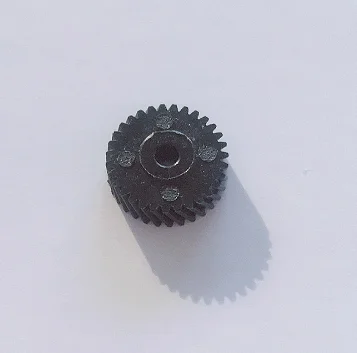Engineers and designers can’t view plastic gears as just metal gears cast in thermoplastic. They must pay attention to special issues and factors unique to plastic material gears. Actually, plastic gear style requires attention to details that have no effect on metal gears, such as for example heat build-up from hysteresis.
The essential difference in design philosophy between metal and plastic gears is that metal gear design is founded on the strength of a single tooth, while plastic-gear design recognizes load sharing between teeth. Put simply, plastic teeth deflect even more under load and pass on the load 
In general, 
Determine the application’s boundary circumstances, such as temperatures, load, velocity, space, and environment.
Examine the short-term materials properties to determine if the original performance levels are adequate for the application.
Review the plastic’s long-term real estate retention in the specified environment to determine whether the performance levels will be maintained for the life of the part.
Calculate the stress amounts caused by the many loads and speeds using the physical house data.
Compare the calculated values with allowable pressure amounts, then redesign if had a need to provide an adequate safety factor.
Plastic gears fail for most of the same reasons metal ones do, including wear, scoring, plastic flow, pitting, fracture, and fatigue. The cause of these failures can be essentially the same.
The teeth of a loaded rotating gear are subject to stresses at the main of the tooth and at the contact surface. If the gear can be lubricated, the bending tension is the most crucial parameter. Non-lubricated gears, on the other hand, may degrade before a tooth fails. Therefore, contact stress may be the prime aspect in the design of these gears. Plastic gears usually have a complete fillet radius at the tooth root. Therefore, they aren’t as susceptible to stress concentrations as metal gears.
Bending-tension data for engineering thermoplastics is founded on fatigue tests run at specific pitch-series velocities. As a result, a velocity factor should be used in the pitch series when velocity exceeds the test speed. Constant lubrication can boost the allowable stress by a factor of at least 1.5. Much like bending stress the calculation of surface contact stress requires a number of correction factors.
For instance, a velocity factor can be used when the pitch-line velocity exceeds the check velocity. In addition, a factor can be used to account for changes in operating temperature, gear materials, and pressure angle. Stall torque is usually another factor in the look of thermoplastic gears. Frequently gears are subject to a stall torque that is substantially higher than the standard loading torque. If plastic material gears are operate at high speeds, they become vulnerable to hysteresis heating which may get so severe that the gears melt.
There are several approaches to reducing this kind of heating. The favored way is to lessen the peak stress by increasing tooth-root area available for the required torque transmission. Another approach is to reduce stress in one’s teeth by increasing the apparatus diameter.
Using stiffer materials, a material that exhibits much less hysteresis, can also prolong the operational life of plastic gears. To increase a plastic’s stiffness, the crystallinity degrees of crystalline plastics such as acetal and nylon could be increased by digesting techniques that boost the plastic’s stiffness by 25 to 50%.
The most effective method of improving stiffness is to apply fillers, especially glass fiber. Adding glass fibers raises stiffness by 500% to 1 1,000%. Using fillers does have a drawback, though. Unfilled plastics have fatigue endurances an order of magnitude greater than those of metals; adding fillers reduces this benefit. So engineers who would like to use fillers should look at the trade-off between fatigue lifestyle and minimal warmth buildup.
Fillers, however, perform provide another advantage in the power of plastic gears to resist hysteresis failure. Fillers can increase heat conductivity. This helps remove high temperature from the peak stress region at the base of the gear tooth and helps dissipate warmth. Heat removal may be the various other controllable general element that can improve level of resistance to hysteresis failure.
The surrounding medium, whether air or liquid, has a substantial influence on cooling prices in plastic material gears. If a fluid such as an essential oil bath surrounds a gear instead of air, high temperature transfer from the gear to the natural oils is usually 10 situations that of the heat transfer from a plastic material gear to air flow. Agitating the oil or air also enhances heat transfer by a factor of 10. If the cooling medium-again, air flow or oil-is usually cooled by a heat exchanger or through design, heat transfer increases a lot more.